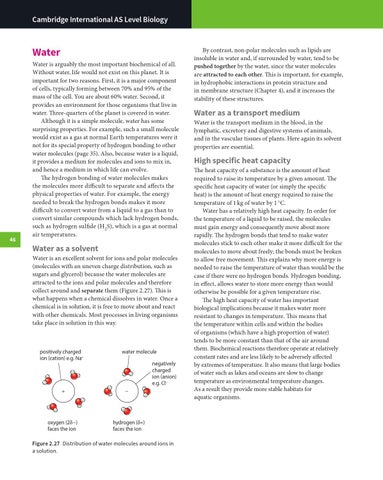Cambridge International AS Level Biology
Water
46
Water is arguably the most important biochemical of all. Without water, life would not exist on this planet. It is important for two reasons. First, it is a major component of cells, typically forming between 70% and 95% of the mass of the cell. You are about 60% water. Second, it provides an environment for those organisms that live in water. Three-quarters of the planet is covered in water. Although it is a simple molecule, water has some surprising properties. For example, such a small molecule would exist as a gas at normal Earth temperatures were it not for its special property of hydrogen bonding to other water molecules (page 35). Also, because water is a liquid, it provides a medium for molecules and ions to mix in, and hence a medium in which life can evolve. The hydrogen bonding of water molecules makes the molecules more difficult to separate and affects the physical properties of water. For example, the energy needed to break the hydrogen bonds makes it more difficult to convert water from a liquid to a gas than to convert similar compounds which lack hydrogen bonds, such as hydrogen sulfide (H2S), which is a gas at normal air temperatures.
Water as a solvent
Water is an excellent solvent for ions and polar molecules (molecules with an uneven charge distribution, such as sugars and glycerol) because the water molecules are attracted to the ions and polar molecules and therefore collect around and separate them (Figure 2.27). This is what happens when a chemical dissolves in water. Once a chemical is in solution, it is free to move about and react with other chemicals. Most processes in living organisms take place in solution in this way.
positively charged ion (cation) e.g. Na+
+
oxygen (2δ −) faces the ion
water molecule negatively charged ion (anion) e.g. Cl− −
hydrogen (δ+) faces the ion
Figure 2.27 Distribution of water molecules around ions in a solution.
By contrast, non-polar molecules such as lipids are insoluble in water and, if surrounded by water, tend to be pushed together by the water, since the water molecules are attracted to each other. This is important, for example, in hydrophobic interactions in protein structure and in membrane structure (Chapter 4), and it increases the stability of these structures.
Water as a transport medium
Water is the transport medium in the blood, in the lymphatic, excretory and digestive systems of animals, and in the vascular tissues of plants. Here again its solvent properties are essential.
High specific heat capacity
The heat capacity of a substance is the amount of heat required to raise its temperature by a given amount. The specific heat capacity of water (or simply the specific heat) is the amount of heat energy required to raise the temperature of 1 kg of water by 1 °C. Water has a relatively high heat capacity. In order for the temperature of a liquid to be raised, the molecules must gain energy and consequently move about more rapidly. The hydrogen bonds that tend to make water molecules stick to each other make it more difficult for the molecules to move about freely; the bonds must be broken to allow free movement. This explains why more energy is needed to raise the temperature of water than would be the case if there were no hydrogen bonds. Hydrogen bonding, in effect, allows water to store more energy than would otherwise be possible for a given temperature rise. The high heat capacity of water has important biological implications because it makes water more resistant to changes in temperature. This means that the temperature within cells and within the bodies of organisms (which have a high proportion of water) tends to be more constant than that of the air around them. Biochemical reactions therefore operate at relatively constant rates and are less likely to be adversely affected by extremes of temperature. It also means that large bodies of water such as lakes and oceans are slow to change temperature as environmental temperature changes. As a result they provide more stable habitats for aquatic organisms.
